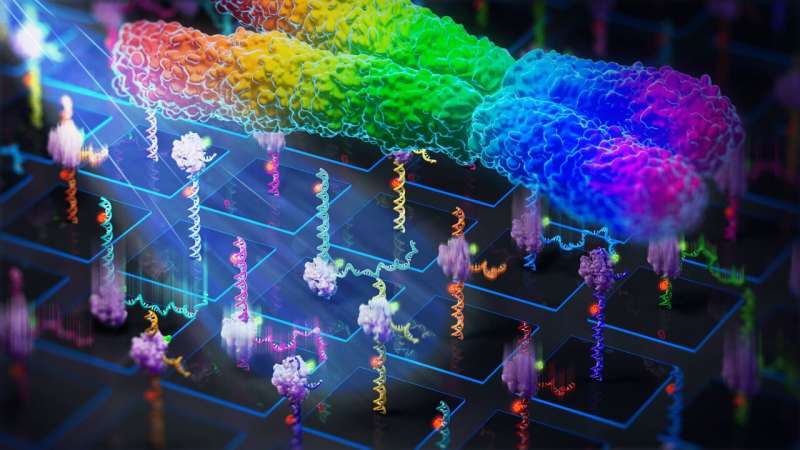This article has been reviewed according to Science X's editorial process and policies. Editors have highlighted the following attributes while ensuring the content's credibility:
fact-checked
peer-reviewed publication
trusted source
proofread
New approach for profiling complex dynamics at the single-molecule level

A team of researchers led by Professor Sebastian Deindl at Uppsala University has developed a pioneering method that vastly improves the ability to observe and analyze complex biological processes at the single-molecule level. Their work is published in the journal Science.
"With our new technique, we can now extend single-molecule biophysics to the genome scale. This advance is expected to significantly deepen our understanding of how nucleic-acid interacting proteins function in both health and disease," says Professor Deindl, the senior author of the study.
The method, which is called MUSCLE (MUltiplexed Single-molecule Characterization at the Library scalE), opens the door to more accurate and comprehensive studies of biological systems, where understanding the full spectrum of molecular behavior is critical. It is expected to have a profound impact on the study of complex molecular dynamics as a function of sequence or chemical space, enabling researchers to explore previously uncharted territories in biology.
The newly developed method overcomes a significant limitation in the field of single-molecule fluorescence microscopy, which until now has been restricted by low throughput due to the laborious nature of analyzing one sample at a time. Traditional approaches have been limited to studying a small number of representative samples, which could lead to biases and missed opportunities for discovering novel insights within large libraries of molecules.
MUSCLE addresses this challenge by combining the mechanistic insights from single-molecule fluorescence microscopy with the high throughput capabilities of next-generation sequencing. The workflow begins by attaching a library of fluorescently labeled molecules onto a surface known as an Illumina MiSeq flow cell. This flow cell is then placed onto a single-molecule fluorescence microscope using a 3D-printed adapter, allowing researchers to observe the real-time dynamics of individual molecules across multiple fields of view.
After imaging, the flow cell is subjected to standard Illumina sequencing, which generates clusters of identical copies from the molecules previously observed. These clusters are then matched with the corresponding molecules based on their positions on the flow cell.
"Spatially registering the single-molecule imaging and Illumina sequencing data turned out to be extremely challenging, but the problem is now solved," says Dr. Anton Sabantsev, joint first author of the study.
This innovative approach allows researchers to simultaneously profile the dynamics of a vast array of samples, providing a more comprehensive understanding of complex biological processes.
"Our method allows for the direct observation of dynamic molecular behaviors across extensive libraries, significantly enhancing our ability to uncover general trends, outlier behaviors, and unique dynamic signatures that would otherwise remain hidden. It is poised to transform how we study the intricate dynamics of biomolecules, with broad applications across molecular biology, genetics and drug discovery," says Professor Deindl.
The joint first authors of the study, Dr. Javier Aguirre Rivera, Dr. Guanzhong Mao, Dr. Sabantsev and M. Panfilov, each made significant contributions to the development and validation of this new technique.
"Key to this very challenging multi-year effort was the wonderful teamwork among our members. Everyone brought something different to the table, which was crucial for overcoming the technical hurdles we faced," says Dr. Mao.
The research team also included Magnus Lindell from the SciLifeLab National Genomics Infrastructure in Uppsala, whose expertise was instrumental in integrating next-generation sequencing into the MUSCLE workflow. In their initial experiments, the team applied the method to profile DNA hairpin dynamics and Cas9-induced DNA unwinding/rewinding. Their findings revealed unexpected behaviors in certain target sequences, underscoring the method's potential to unlock new biological insights.
Given its reliance on widely available fluorescence microscopy and MiSeq instruments, along with the ease of fabricating the necessary adapter using 3D printing, the method is highly accessible to the broader scientific community. It can be adapted to study a wide range of proteins interacting with nucleic acids, as well as DNA-barcoded proteins, compounds or ligands.
More information: J. Aguirre Rivera et al, Massively parallel analysis of single-molecule dynamics on next-generation sequencing chips, Science (2024). DOI: 10.1126/science.adn5371
Journal information: Science
Provided by Uppsala University




















